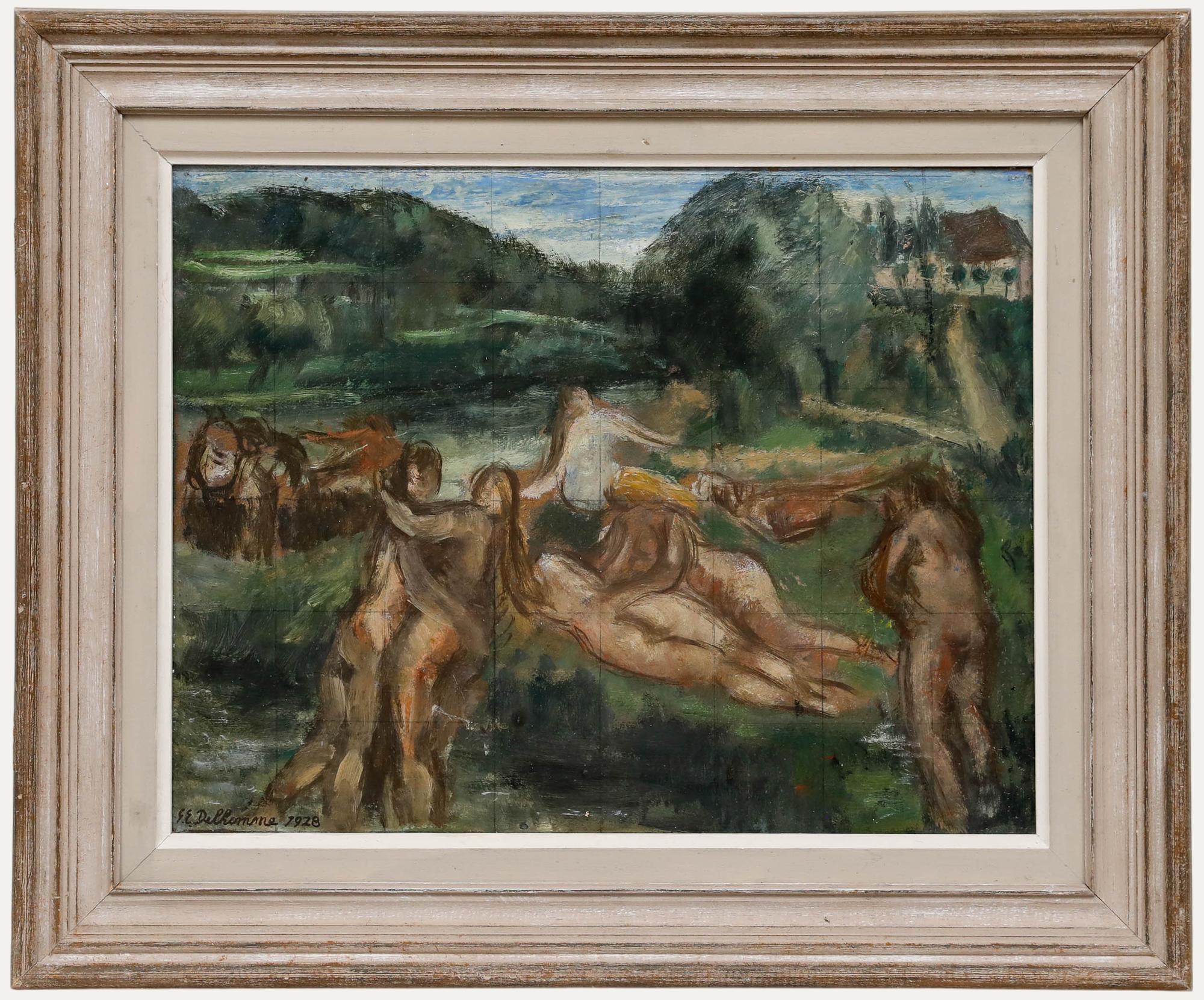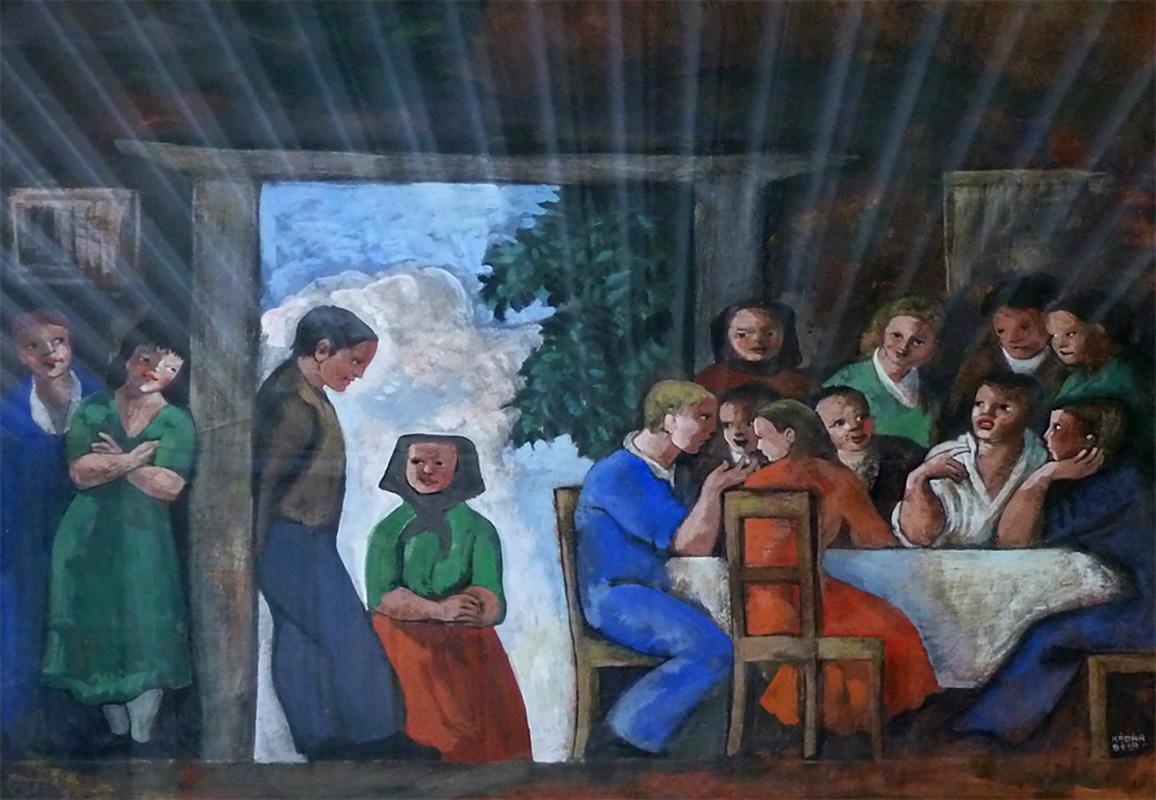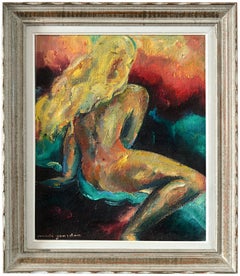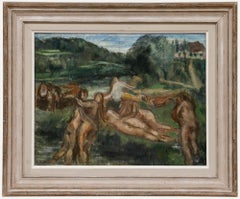Items Similar to Amedee de La PATELLIERE, Eclipse with 4 Characters, 1928
Want more images or videos?
Request additional images or videos from the seller
1 of 9
Amédée de la PatellièreAmedee de La PATELLIERE, Eclipse with 4 Characters, 19281928
1928
$4,500
£3,409.60
€3,912.25
CA$6,332.23
A$6,960.86
CHF 3,658.31
MX$84,530.18
NOK 45,636.47
SEK 43,237.35
DKK 29,198.11
About the Item
Oil on canvas by Amedee de La PATELLIERE, France, 1928. Eclipse with four characters. With frame: 63x54 cm - 24.8x21.25 inches ; without frame: 41x33 cm - 16.15x13 inches. Format 6F. Signed lower right "A. de la Patellière". In its period Montparnasse frame in carved wood. Comes with its certificate of authenticity by Mr. Yves de la Patellière from June 15, 1986. Yves de la Patellière, now deceased, was one of the sons of Amédée's older brother. He was therefore the nephew and manager of the work of Amédée at the time of this certificate.
Biography
Amédée de La Patellière was born in the vineyards of Nantes, at the Château de Bois-Benoît in Vallet. He spent his childhood in the countryside, which was to be one of the sources of inspiration for his work. After preparing for the Naval School, he entered the Académie Julian in Paris in 1910. He then divided his time between his family home in Bois-Benoît, Paris, and the south of Seine-et-Oise. He was wounded in action during the First World War. On his return from the war in 1919, he spent some time in Tunisia from where he brought back luminous sketches. Settled in Paris, he married Suzanne Lamon in 1924. He was a professor at the Académie Ranson in Paris from 1929 to 1932 and was one of the founding artists of the Young Painting group (with Yves Alix, Robert Lotiron and Louis-Joseph Soulas). contemporary. He was also the friend of Bertrand Mogniat-Duclos. Like his friends André Dunoyer de Segonzac and Henri Le Fauconnier, he announces a form of expressionism, where the dense and dark material, organized in chiaroscuro, gives a solid volume to the rustic subjects he likes. We perceive a distant influence of cubism in his structured compositions, but with an expression of intense gravity (The Rest in the Cellar, National Museum of Modern Art, Paris). His earthy roughness, however, excludes the picturesque, because the artist seems more preoccupied with plasticity than realism.
During stays in Provence, in the last years of his life (1930-1931), his palette diversified. He met the writer Jean Giono, for whom he produced the illustrations for his novel Colline, and whose lyricism was very close to his own.
Seriously ill in 1929, he died in Paris in 1932.
Exhibitions
1945: retrospective at the National Museum of Modern Art in Paris
1973: exhibition at the Galliera museum in Paris
2014: exhibition co-produced by the Nantes Museum of Fine Arts, La Piscine de Roubaix, the Mont-de-Piété Museum in Bergues and the MUDO - Musée de l'Oise de Beauvais
Library
Roger Brielle, Amédée de La Patellière, collection « Les Peintres nouveaux » n° 46, Paris, Gallimard, 1932
Jean Alazard, Amédée de la Patelliere, Pierre Cailler, Genève, 1953
Michel Charzat, La Patellière, peintre du réel et du merveilleux, in "La Jeune peinture française", Hazan, Paris, 2010 pp. 87-92
Patrick Descamps, Amédée de la Patelliere (1890-1932), les éclats de l'ombre, Catalogue d'exposition, Musée des Beaux-Arts de Nantes, Gourcuff Gradenigo, Paris , 2014
Museums
Paris, Musée National d'Art Moderne, Centre Georges Pompidou
Château de Saint-Ouen
New York
Moscou
Tokyo
- Creator:Amédée de la Patellière (1890 - 1932, French)
- Creation Year:1928
- Dimensions:Height: 24.81 in (63 cm)Width: 21.26 in (54 cm)Depth: 3.15 in (8 cm)
- Medium:
- Movement & Style:
- Period:
- Condition:
- Gallery Location:Saint Amans des cots, FR
- Reference Number:1stDibs: LU1088214254762
About the Seller
5.0
Vetted Professional Seller
Every seller passes strict standards for authenticity and reliability
1stDibs seller since 2018
38 sales on 1stDibs
- ShippingRetrieving quote...Shipping from: Saint Amans des cots, France
- Return Policy
Authenticity Guarantee
In the unlikely event there’s an issue with an item’s authenticity, contact us within 1 year for a full refund. DetailsMoney-Back Guarantee
If your item is not as described, is damaged in transit, or does not arrive, contact us within 7 days for a full refund. Details24-Hour Cancellation
You have a 24-hour grace period in which to reconsider your purchase, with no questions asked.Vetted Professional Sellers
Our world-class sellers must adhere to strict standards for service and quality, maintaining the integrity of our listings.Price-Match Guarantee
If you find that a seller listed the same item for a lower price elsewhere, we’ll match it.Trusted Global Delivery
Our best-in-class carrier network provides specialized shipping options worldwide, including custom delivery.More From This Seller
View AllToujours la Vie Recommence
By Edouard Goerg
Located in Saint Amans des cots, FR
Oil on canvas by Edouard Goerg (1893-1969), France, 1958. Life is always the same. Acquired in 2017 from the personal collection of Edouard Goerg. Measurements : with frame : 62.5x53.4 cm - 24.6x21 inches, without frame : 55x46 cm - 21.7x18.1 inches, format 10F. Signed "E.Goerg" (see photo).
Preserved by the painter, then by his family since his death in 1969, this painting appeared in 2017. Entitled "Always life begins again", it is a crepuscular work. Testamentary one could say, so much the statement which is made there is definitive. The fact that he kept it until his death tends to consolidate this vision. Far from the empty looks and death faces of the rebellious era of sarcastic expressionism, the terrifying and compassionate testimony of the Spanish war, and the post-WWII flower women, we are dealing here with a a form of reasonable abdication, but honest. This idea that although everything changes, nothing changes. Changed times, actors, ideas, the same comedy occupies the society. Having given up the idea of changing the latter, Goerg accepts the fact that the only alternative is to stay there or get lost. But stay afloat with his values, completely independent, whatever the cost is.
This work is similar to La Vie Recommence of 1935, reproduced on page 54 of Gaston Diehl's book devoted to the painter (Éditions de Clermont, 1947). On the latter, the artist depicts his vision of life, from birth to death, made of hope, fear, cruelty, resignation and fatality. 23 years later, Toujours La Vie Recommence shows us the road traveled by the painter. It is no longer a matter of denunciation, but ultimately of acceptance of reality and the difficulty of staying there yourself.
The admirer of Hieronymus Bosch gives us an inspired composition. The hand of God, the only expression of physical beauty in this work, comes down from heaven to give life. Symbolically, it holds an egg that dispenses the element from which the human protagonists find their birth, and in which they move and tangle more than they impose. Beautiful allegory of society. Four characters, two women and two men evolve in this societal marigot. The man in the foreground, ruddy face, evolves with ease. His body is supple, flexible, adaptable. The woman on the left observes him with admiration. Obviously, this man is in his place and causes rapture. The right man with massive shoulders and wrapped, shows a physical maladjustment to the activity he is doing. He struggles to stay afloat, his face expresses effort, even exhaustion. But he assumes. He does with what he has, with what he is. The other woman shows him the greatest indifference. What is not the case of the demonic archangel (recurrent in the works of Bosch) with the stunted body, who leads the dance and holds this character, we understand the painter, under his control as to have fun. As this character cannot change bodies, Goerg cannot change values. He does it with. Had he not said to the critic Roger Brielle: "Independents, sensitive and just men, that's what we must strive to stay in this world in disarray". Goerg will have come to narrative expressionism to give us a balance sheet allegory of his deep self and his condition.
Édouard Goerg is one of the major artists of his generation. Coming from a Champagne family, he was born in Sidney, Australia, in 1893, during a professional stay of his father. After passing through London, he arrives in Paris at the age of seven. At twenty, between 1913 and 1914, he studieds painting at the Académie Ranson with Maurice Denis and Paul Sérusier. He travels to Italy and India. Mobilized in 1914, he is sent to Artois, then to Argonne. From 1920, he exhibits at the Salon des Independants, then at the Salon d'Automne where he joins with Laboureur. At Berthe Weil, in 1924, he participates in the exhibitions of the Gromaire group, a prelude to a series of exhibitions in Paris (Berthe Weill, Bernheim Jeune), as in Brussels (Le Centaure). Goerg illustrates books including Table of the beyond by F.Boutet. In 1928, he meets Paul Guillaume who exhibits his works in Boston and the Art Institute of Chicago. He continues to show his works, satires of the bourgeois manners, at Bernheim Jeune, then at Lucie Krogh. In 1934, he travels to Belgium and Holland where he paints surrealist paintings that will be exhibited at Jeanne Castel. In 1935-1936, he meets Aragon, who opened the doors of the houses of the cultures created by the Association of Writers and Revolutionary Artists. The Spanish war and the Second World War mark it deeply. He must protect his daughter and his Jewish women...
Category
1950s Expressionist Figurative Paintings
Materials
Canvas, Oil
Edouard Goerg, Les 3 Brunes, Large Oil on Canvas, 1955
By Edouard Goerg
Located in Saint Amans des cots, FR
Large oil on canvas by Edouard GOERG (1893-1969), France, 1955. LES 3 BRUNES. With frame : 114x95cm - 44.9x37.4 inches ; without frame : 92.2x73 cm - 36.3x28.75 inches. Format 30F. S...
Category
1950s Expressionist Figurative Paintings
Materials
Canvas, Oil
School of Paris, Barbara, Oil on Canvas, 1950s
Located in Saint Amans des cots, FR
This captivating 1950s oil on canvas portrait, possibly depicting the French singer Barbara, exudes an air of mystery and existential reflection. While the identity of the subject re...
Category
1950s Neo-Expressionist Figurative Paintings
Materials
Canvas, Oil
Dream
Located in Saint Amans des cots, FR
Oil on canvas by Madé Gourdon, France, 1960s. "Dream". with frame: 70x61 cm - without frame: 55x46 cm. 10F format. Signed "Madé Gourdon" in the lower left. In its frame Montparnasse....
Category
1960s Expressionist Figurative Paintings
Materials
Canvas, Burlap, Oil
$2,800
Dominique PERY, Marianne, Oil on canvas 1987
Located in Saint Amans des cots, FR
Oil on canvas by Dominique PERY, France, 1987. Nude named "Marianne". 73x60 cm - 28.75x23.6 in. 20F Format. Signed "D.Péry" lower right (see photo). Countersigned twice and dated 198...
Category
1980s Neo-Expressionist Figurative Paintings
Materials
Canvas, Oil
Laure Bruni, Oil on canvas, "Landscape of Drôme", 1926
Located in Saint Amans des cots, FR
Oil on canvas by Laure Stella BRUNI, France, 1926. Landscape of Drome. with frame: 109x90x8 cm - 42.9x35.4x3.15 inches ; without frame: 92x73 cm - 36.2x28.75 inches. 30F format. Sign...
Category
1920s Neo-Expressionist Landscape Paintings
Materials
Canvas, Oil
You May Also Like
Abstract Composition - Oil Painting by Tato - Early 20th Century
Located in Roma, IT
This Abstract Composition was realized by the Italian artist Tato (Guglielmo Sansoni, 1896-1974) in the early 20th century.
Oil painting on canvas. ...
Category
Early 20th Century Abstract Figurative Paintings
Materials
Oil
Détente, 1924-25 - Oil paint, 69x80 cm, framed
By Jean Bouchaud
Located in Nice, FR
Oil on canvas, signed lower right.
Jean Bouchaud (1891 in Saint Herblain near Nantes – 1977 in Nantes) was a French painter. He was fascinated by travel since his childhood seeing s...
Category
1920s Modern Figurative Paintings
Materials
Oil
$4,547 Sale Price
34% Off
Georges Eugene Delhomme (1904-1989) - 1928 Oil, Figures in a Landscape
Located in Corsham, GB
This impressionistic painting portrays a serene pastoral scene, where nude figures are gracefully integrated into a lush, verdant landscape. The composition skilfully balances the or...
Category
Early 20th Century Figurative Paintings
Materials
Oil
The Family, circa 1930's
By Bela Kadar
Located in London, GB
BELA KADAR 1877-1956
Budapest 1877-1956 (Hungarian)
Title: The Family, circa 1930's
Technique: Original Signed Tempera on paper
Image size: 90 x 71.5 cm / 35.4 x 28.2 in
Additional Information: The work is hand signed "Kadar Bela...
Category
1930s Expressionist Figurative Prints
Materials
Tempera
"Theatrical Scene, " Art Deco Painting with Tragedy, Comedy in Celestial Setting
Located in Philadelphia, PA
This extraordinary, almost surreal scene by one of America's leading muralists in the Art Deco period, Eugene Savage, depicts a floating female nude on the stage, with figures of Com...
Category
Vintage 1940s American Art Deco Paintings
Materials
Paint
'Le Jugement de Pâris' by Georges Charles Dufresne (1876 – 1936) French Painter
Located in Knokke, BE
Georges Charles Dufresne
Millemont 1876 – 1936 La Seyne-sur-Mer
French Painter
'Le Jugement de Pâris – The Judgment of Paris'
Signature: signed lower right 'dufresne'
Medium: oil o...
Category
Early 19th Century Fauvist Landscape Paintings
Materials
Canvas, Oil
More Ways To Browse
Antique Character
Paris Sketch
La Piscine
Cigar Painting
Diver Painting
French Military Art
Jean Fusaro
Mid Century Clown Painting
Painting Robot
Saturday Evening Post Leyendecker
Skeleton Painting
2 Boys And A Girl Painting
Acrylic And Butterflies
African American Oil Painting
Armando Reveron
Holy Family Art
Lawrence Tadema
Man Smoking Art






